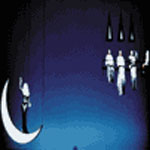|
|
|
[INDEX]
 The
US premiere at the Lincoln Center Festival of White Raven, an opera by
American composer Philip Glass and his director/designer associate Robert
Wilson, has been greeted with the cheers and moans that now accompany
most shows by the aging bad boys of New York minimalism. The
US premiere at the Lincoln Center Festival of White Raven, an opera by
American composer Philip Glass and his director/designer associate Robert
Wilson, has been greeted with the cheers and moans that now accompany
most shows by the aging bad boys of New York minimalism.
The opera was commissioned in 1991 by the Portuguese government to celebrate
the country's 15th-century maritime explorers, including Vasco de Gama.
It was premiered at Expo '98 in Lisbon and has been toured and slightly
reworked in the intervening years. In terms of international publicity,
Portugal got its money’s worth by hiring the famous team of Glass and
Wilson. But to judge by the uneven show seen at the State Theater on July
14, the artistic value of this enterprise is more doubtful.
The ostensible subject matter is full of rich potential. There has never
been a grander adventure than that of medieval navigators sailing off
the edge of the map in search of the unknown. The voyages of Portuguese
explorers opened Africa and the Indies to trade and colonization, leading
to cultural exchanges that were to alter man’s perception of his place
in the universe. Some historical documents are quoted in Portuguese author
Luisa Costes Gomes’s libretto to give period color to the work, but much
of the recitation is pseudo-philosophical prose poetry that the New York
Times called “ponderous blather .”
Wilson sets White Raven in places real and imaginary: the Portuguese royal
court, Africa, India, Brazil, underwater, on a storm-tossed sea, and in
the jungle. He peoples the stage with dozens of figures from history and
mythology, including Siamese Twins, Miss Universe, Dogman, Spoonman, a
headless man, a dragon, colorful natives and outlandishly dressed freaks.
As one sat through the three-hour show, one hoped that some pattern or
wisdom would emerge from the crazy quilt of images and texts, but it was
not to be. All the familiar sounds and shapes from the Glass/ Wilson grab
bag were paraded, but instead of jelling into a coherent statement, this
opera never amounted to much more than stitched together scraps from the
floor of the Glass/Wilson atelier. As Newsday’s Justin Davidson wrote,
“The problem with an opera about everything is that it doesn't matter
much what's in it. White Raven contains no characters, only emblems, singing
stick figures with nothing to express. It has no plot, only roving allusions.”
There were some ravishingly lovely images and tableaux. Lucinda Childs’s
Act 2, Scene 1 solo “Exploration under water”, during which she recited
a passage from Wilhelm Reich about the color blue was mesmerising. The
silhouettes in Act 3, Scene 4 were crisply stunning. The Writer and Child
in a Little Boat (Act 3, Scene 2) was poetic. But the opera’s brilliant
core was overlayed with silliness, note-spinning, and unmitigated nonsense.
For every touch of the sublime, there was a great blob of kitsch, such
as the tatty shipwreck scene (Overture 2), the ravens that looked like
penguins, and the silly Burning Statue and aluminum-coated firemen. Most
disturbing was a vein of puerile camp typified by the gratuitous introduction
of Dorothy and the Tin Man from the Wizard of Oz, and Three Scratching
Scientists.
Design-wise, White Raven marks a low point in Wilson’s oeuvre. Wilson’s
best work (such as the Met Opera Lohegrin) is notable for bewitchingly
beautful, Rothkoesque use of light, shadow, and color. Yet some of his
White Raven sets and Moidele Bickel’s costumes look like they were assembled
by a kindergarten art class. Wilson’s formerly restrained stylized gestures
inspired by the dance traditions of Java, Bali, and Japan have here degenerated
into whirling dervish leaping and spasmodic twitching.
Some critics find that Glass’s score for White Raven represents a great
leap forward - which means he added two new chords and a tuba to his usual
sewing machine music. Only the choruses (directed by Judith Clurman) stand
out as worthy of commemoration. The final chorus could be part of a great
new age Te Deum. Glass specialist Dennis Russell Davies conducted the
American Composers Orchestra with conviction.
Reviews of White Raven were mixed. Philadelphia Inquirer critic David
Patrick Stearns put the case for the prosecution, calling the work “a
huge convention of cliches ... uninterested in communicating anything
important.” The New York Times called the opera “a frustratingly uneven
work” and faulted Glass’s score for its padding and filler, while admiring
Wilson’s “beautifully surreal stage show.”
In the end, White Raven fills a few hours with mildly intriguing images
and sounds having all the earmarks of a commission, that is, a product
purchased to fill a political need. Perhaps the scariest thing is that
White Raven is only half of an operatic diptych in progress. The other
part promises to treat "the civilization and development of Islam from
about 1000 A.D. to 1500 A.D."
Credits
White Raven Music by Philip Glass. Libretto by Luisa Costa Gomes. Directed
by Robert Wilson. With Lucinda Childs, Ana Paula Russo, Janice Felty,
Herbert Perry and Vincent Dion Stringer. American Composers Orchestra
and White Raven Opera Chorus conducted by Dennis Russel Davies. New York
State Theater, Lincoln Center. Presented by Lincoln Center Festival. July
10-14, 2001.
The Lincoln Center Festival continues through July 29, 2001.
>Lincoln Center Festival 2001.
[INDEX] |
|
|

